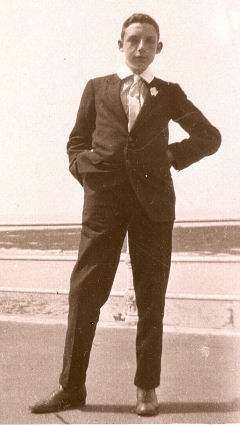Father: Harry Finch Reynolds (1865-1947)
Mother: Sarah Constance Cox (1867-1936)
Birth: 2nd December, 1907, at Calverton, St Albans
Baptism: 8th March 1908 at Sandridge. Godparents were William Horn and Ethel Cox
|
Gerald's father built Calverton, in about 1901, in a prominent position at the head of St Peter's Street. St Albans, close to Gerald's grandfather's farm.
Gerald on Seagull, in the grounds at Calverton, circ 1914
After the First World War the family moved to Hammonds Farm, Sandridge |
 |
 |
Gerald went to St Albans School as a day pupil but was clearly no seen as academic (I suspect today he would have been diagnosed as dyslexic). How would he be able to get a place at public school? His headmaster apparently recommended that if he was entered for one of the less prestigious schools, St Lawrence at Ramsgate, and "unfortunately" was sick on the day of the entrance exam (so he hadn't failed it) there was a hope. As one of his cousins had been to St Lawrence and done remarkably well he might be accepted on personal recommendation. ... So in 1922 he went to the school, stuck at the bottom of the lowest class for a few terms, and left. In School Uniform at Ramsgate, 1922-23 |
|
After leaving school he helped on his father's farm, Hammonds, where he was responsible for the poultry.
Gerald Reynolds at the back of Hammonds Farm in 1936 |
|
|
In 1936 one of Gerald's friends had a problem. He had promised to take his fiancée Betty to a dance, and at the last moment he was unable to go. Rather than waste the tickets he asked Gerald to take Betty ...
Marriage: 20th February, 1937 at St Albans to Frances Bertha (Betty) Locke Picture to come
Son: 23 March 1938 - Christopher Finch Reynolds
|
Gerald with Dan and Trixie at Eylotts, Sandridge in 1939 Gerald and Betty moved into a new house, Eylotts, on Hammonds Farm, taking over the poultry sheds with a view to running a poultry farm. After a couple of years it was clear that it was not going to be profitable and he gave up farming. See also Hammonds Farm and Eylotts, Sandridge, 19th/20th Century |
 |
 |
The story is that Gerald was talking to his St Albans solicitor about the finances of the poultry farm, and it was suggested that he took on running a shop. He did not want one where all his many relatives might be customers and the solicitor had a recently widowed relative who was trying to sell a business in Somerset. Gerald and Betty went to see the shop, liked it, and walked down to the Esplanade where there was this attractive harbour full of water. They returned to the shop, agreed to take the lease - and returned to the harbour after the tide had gone out to see acres of very sticky mud! Gerald with Dan on the Esplanade at Watchet in 1939. Taking Dan to Watchet was a big mistake. Dan was used to spending all day on the farm and suddenly he found himself spending most of his time in a pen at the back of a shop in a small town. It was not long before a new, more suitable home was found for Dan. |
|
Towards the end of 1940 Gerald was called up, and was accepted as A1. He spent six months training and then there was a serious recurrence of the asthma he had had since a child. He was invalided out of the army just in time as the rest of his unit was sent to Tobruck where they were captured and ended up in a German Prisoner of War camp. On returning to Watchet he continued to run the shop and also served as an air raid warden. Apparently the biggest excitement was when a land mine fell in a field a mile of so from Watchet. |
 |
 |
In 1945 the family moved to 120 Queen Street, Newton Abbot, where Gerald ran the business of Newsagent and Tobacconist. However he kept the shop at Watchet, with Mrs Lodge as manager for about 5 or 6 years. |
To be continued
If you can add to the information given above tell me.
| March 2012 | Major update with pictures | |